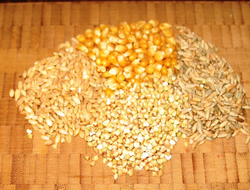Selenium: one of the trace minerals
Published: November 23, 2018
Selenium is a non-metal, essential trace mineral required by your body in very small concentrations: less than one part per million.
This is less than 0.01% of your total body weight: approximately 5 g for a 54 kg person.
Although only very small amounts of selenium are required for good health, selenium is involved in a host of important metabolic activities in your body.
Selenium deficiency is rare in the North American population, but may occur for a variety of reasons.
The importance of selenium in metabolic activities has given rise to research concerning the association between body selenium levels and various health conditions.
In addition, the association between selenium supplementation and its effect on health conditions such as various cancers, cardiovascular disease, thyroid disease and other health conditions has been studied.
While selenium supplementation is beneficial in cases of diagnosed selenium deficiency, broader health benefits have yet to be confirmed.
However, there are a great many selenium supplement products commercially available often making claims about various protective health benefits.
This article provides an outline of the various metabolic functions of selenium, the recommended daily intake, selenium deficiency and toxicity, selenium supplementation, and the body’s metabolism of selenium.
Functions
Amino acid synthesis
Selenium can be incorporated into two amino acids, methionine and cysteine, which usually contain sulfur.
Selenomethionine and selenocysteine may then be incorporated into a variety of proteins which participate in a variety of metabolic functions.
Antioxidant activity
Selenium acts as a co-factor for the enzyme glutathione peroxidase which along with vitamin E helps prevent free-radical formation. Free radical formation occurs through a chain reaction, but glutathione peroxidase inhibits the reaction before it can begin.
Fundamentally, glutathione peroxidase neutralises hydrogen peroxide which is a product of many metabolic reactions in your body, and which has the potential to cause damage to cell membranes and components.
Different forms of glutathione peroxidase are located in your liver, kidney, red blood cells, plasma, gastrointestinal tract, heart and lung.
Thyroid hormone
Iodythyronine deiodinases contain selenocysteine. These enzymes are involved in iodine metabolism associated with your thyroid hormones such as the conversion of thyroxine (T4) to the main active form of the hormone: triiodothyronine (T3).
This hormone regulates metabolism in general as well as normal growth and development.
Other functions include:...link to the full article to learn more.
References
1.
Gropper, S.S., Smith, J.L. & Groff, J.L. (2005). Advanced Nutrition and Human Metabolism (4thEd.). Belmont, CA: Thomson Wadsworth.
2.
Whitney, E. & Rady Rolfes, S. (2005). Understanding Nutrition. Belmont, CA: Thomson Wadsworth
3.
Benardot, D. (2006). Advanced Sports Nutrition. Human Kinetics. USA
4.
Centre for Science in the Public InterestCSPI January/February 2010, July/August 2010, September 2011, March 2015, May 2014

